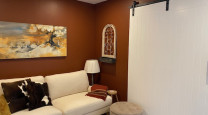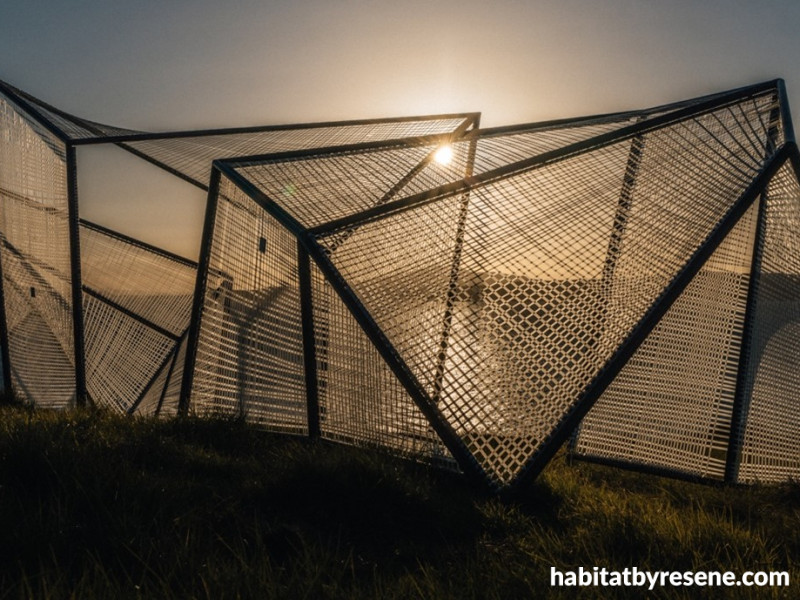
A sculpture with a striking silhouette pushes eco-awareness in the construction and design fields
14 Sep 2022
Standing on a green hillside on Waiheke Island in the Hauraki Gulf, black angular lines mimic the contours of the surrounding landscape. The angles of an eye-catching form make their mark by reaching up to the sky and in opposing directions.
Courtesy of Waiheke artist and architectural designer Francisco Carbajal, the structure is an artwork, its geometric plains providing a shelter for visitors who choose to step inside the installation.
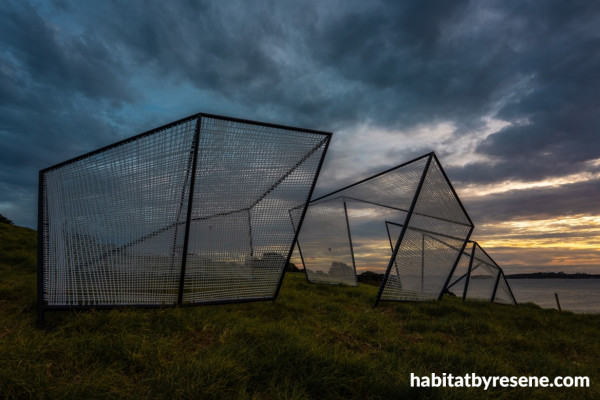
The striking Unified Peaks sculpture by Waiheke artist and architectural designer Francisco Carbajal was crafted using upcycled items found on construction sites. Using a basecoat of Resene Galvo One followed by Resene Sonyx 101 in Resene Black, its black frame defines its form without overwhelming the landscape. Image by Peter Rees.
Resene provided the paint on Unified Peaks, a favourite at the island’s Sculpture on the Gulf art show this year. It has now moved to The Heke brewery on the island until the end of this year.
The sculpture is part of the constant art buzz on the island, known for its celebration of creativity among guests and residents.
It was part of Francisco’s attempt to draw attention to excessive waste and the way eco-focused designs/architecture can counter this – notably through his architecture practice FNC Designs.
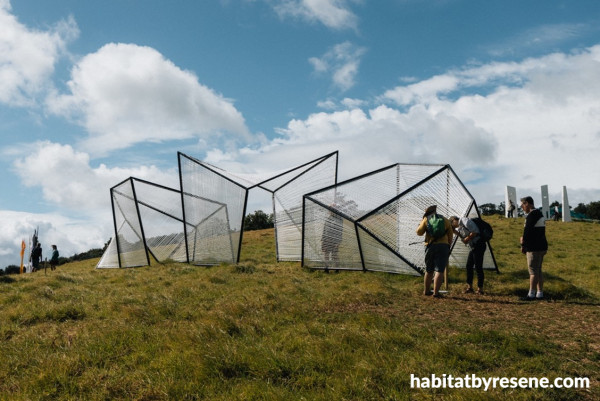
Francisco’s work being admired by visitors at the Sculpture on the Gulf art show on Waiheke Island this year. The artwork has now relocated to the local The Heke brewery. Image by Peter Rees.
Inspired by materials found on construction sites, it was crafted from items and upcycled, using items such as plastic strapping and scaffolding poles.
“I hope the sculpture will show a different way of thinking in the construction industry, and encourage a new sort of discussion,” he says. “I know for everyone involved in the project it was interesting to learn what’s happening in other industries, and we hope the public were interested in it too.”
QR codes were used for people to scan taking them to articles about that industry, whether it be manufacturing, supply, engineering or architecture.
Having received first-class honours for a highly commended thesis on carbon calculation, Francisco teachers architecture and environmental design at the University of Auckland while running his practice FNC Designs.
What are the re-found materials you’ve used to create the sculpture?
For the project we looked at incorporating materials that could be found on the fringe of construction sites. We believed scaffolding would be good to use for the sculpture’s structure, which was supplied by Affordable Scaffolding from various sites around Auckland. Through collecting pre-used scaffolding from construction sites we were able to assemble sufficient supply for the design. We explored salvaging the strapping from multiple sources, but they couldn’t supply enough for our project.
What was your involvement with Resene? Why did collaborating with Resene appeal to you?
I’ve been using Resene products throughout my whole career and I believe that they’re a trustworthy organisation and amiable to work with. They do a lot for our industry and support many amazing events. They are the experts at what they do. This was not the first project Resene has supported with me before, so I already knew that they were interested in projects such as Unified Peaks. Especially a project that wanted to discuss sustainable practice in their industry.
What Resene colour did you use on the sculpture?
A basecoat of Resene Galvo One was followed by Resene Sonyx 101 in Resene Black. Black is contemporary and edgy emphasising the form of the structure whilst expressing a sense of elegance. The colour also remains consistent throughout the day, framing a canvas for the ever-changing strapping throughout the day.
What was the role of the engineers and suppliers you collaborated with on the sculpture? What was their input?
We worked with ProConsult on our design and shared what we were looking to achieve. Once we had finalised/determined the design brief, there was correspondence between FNC Designs and ProConsult in regard to adjusting the scale of the sculpture.
All our suppliers provided some form of input about Unified Peaks, from the precise cutting of our scaffolding poles by Fine Laser Cutting, to selecting products with the help of Karmen at Resene. For scaffolding, we needed steel members, to meet the structural requirements. For the strapping, we needed to understand durability and tension.
For the paint, we were after durability and an appropriate colour that would complement the strapping. Resene aided in selecting the correct product for us. There was a collaboration for all parties involved.
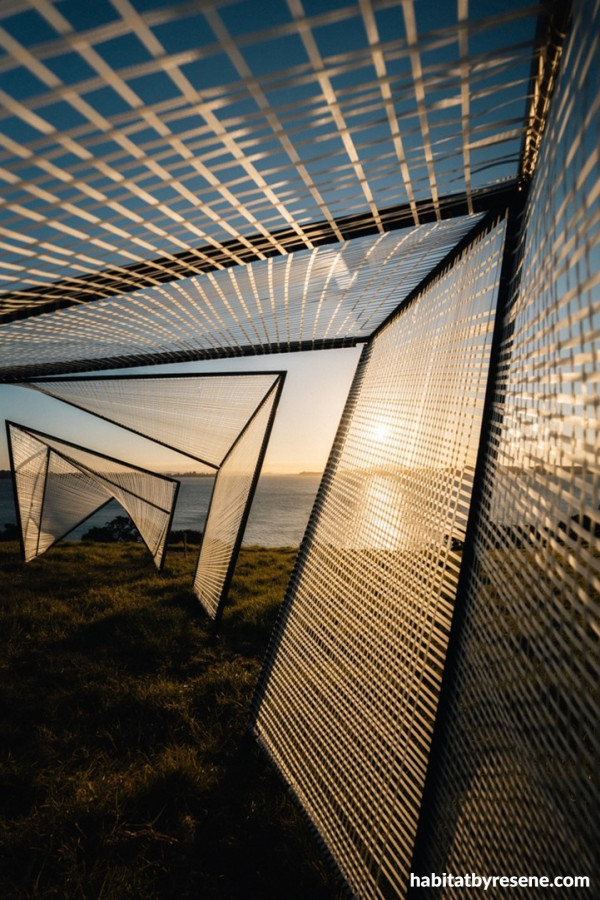
The aim behind the sculpture was to draw attention to the large amount of waste created in the construction and architecture industries. Image by Peter Rees.
Was it just yourself working on the project? Did anyone fund/sponsor the project?
Everyone involved contributed time, resources or funding. This project would never have eventuated without its sponsors and volunteers. We were lucky enough to get a lot of support for this project including students from Waiheke High School. The biggest challenge with Unified Peaks was how to install the strapping and so we recruited students from Waiheke High School to help.
We had anticipated that the strapping would take a considerable amount of time, however, we had almost exhausted all our options before finalising a method of weaving with the guidance of our master weaver. We were able to overcome our time restrictions and deliver the project on time thanks to more than twenty volunteers.
The project team included Francisco Carbajal, Aingaran Manokaran, Benjamin Howard, Mitzi O'Brien, Grayson Croucher, Clare Na and Hye Ryun Lee. Contributing sponsors/suppliers were Vertus Construction, ProConsult, Fine Laser Cutting Services, Affordable Scaffolding, Razorsharp Property Maintenance Ltd, Resene, Integrated Landscape, RLB Packaging, Pukeko Signs.
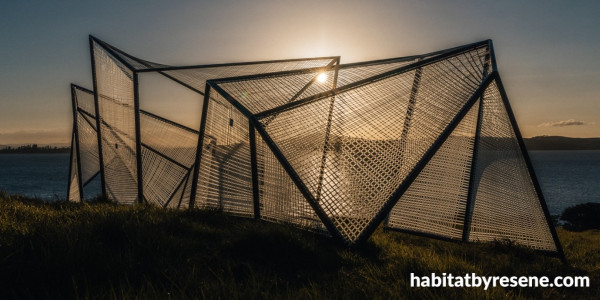
Using Resene products to define the black frame, the result is a structure that provides strong contrast between the white, clear woven strapping with the structure’s edge. Image by Peter Rees.
What do you love about the use of paint in your work? What dimension does it bring to an artwork?
Colour overall, has such an influence on the success of a space. The intention for ‘Unified Peaks’ was to keep the colour scheme simple to complement the form with a sharp contrast between the strapping and the structure. It was also important that the colour selection visually considered its surroundings and that the Resene product could withstand the high salt spray conditions on the headland. Having explored several combinations, we settled on the traditional colour contrast, black and white. The visual combination of black and white accentuated the sculpture’s form without creating an undesirable presence within the landscape.
You’re a climate-conscious design practice – do you feel this should be on equal footing with a beautiful aesthetic of a design project or does sustainability take precedence?
There needs to be a balance between aesthetics and sustainable choices but also, practicality. In most projects, it’s the client that’s making the decisions. What’s most important about sustainable practice, is appealing to the decision makers’ extrinsic values. It’s been proven that the best way to challenge these values is with information. The architectural and construction industries are under a significant shift and one of the biggest difficulties today is keeping up with the relevant information. I also teach at the University of Auckland and have first-hand experience of how the education of sustainable practice is developing the profession.
At FNC Designs we believe in a practical approach to sustainable practice and value making informed decisions with clear implications. Our recommendations aren’t always popular, but it is a success for us when they are. We are constantly improving our knowledge, practice and in-house resources to help with this process.
Find out more about FNC Designs: www.fncdesigns.com
Published: 14 Sep 2022





